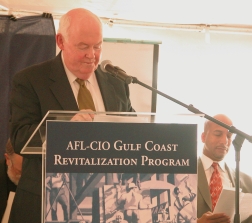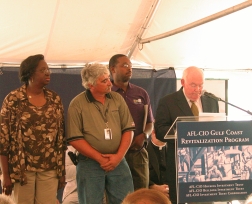 |
| What we are doing reflects the mission of the labor movement to help working people work together to build better lives, says John Sweeney, president, AFL-CIO. (Photo by Angelle Bergeron for ENR) |
While the federal government and timid investors dawdle on the sidelines, contemplating moving into New Orleans when things get back to normal, the AFL-CIO is rolling up its sleeves and investing $1 billion to make recovery a reality. Wednesday, June 14 John Sweeney, AFL-CIO president, announced the AFL-CIO Gulf Coast Revitalization Program, a seven-year, housing and economic development program designed to produce affordable housing, promote home ownership and create good jobs with good wages in construction and other industries throughout the Gulf Coast region.
Sweeney made the announcement, flanked by Edward Sullivan, president of the Building and Construction Trades Dept., Stephen Coyle, CEO, AFL-CIO Housing Investment Trust, James O. Campbell, president of the International Longshoremens Association Local 3000, New Orleans Mayor C. Ray Nagin and a broad range of labor, civic, religious, financial and academic leaders.
We are here to reclaim a city that too often feels like America forgotten, says Sweeney, joined on the platform by local union members. Sweeney says he, like the rest of the world, was shocked to witness the destruction caused by Hurricanes Katrina and Rita last fall and vowed that the AFL-CIO would do everything it could to help the survivors, and help rebuild New Orleans.
 |
| We are here to reclaim a city that too often feels like America forgotten, says Sweeney, joined on stage by local union members (left to right) Gwendolyn Adams, Thomas Conrad and Oliver Armstrong. Housing, transportation, education, and other infrastructure are as essential to the city as dykes or levees. (Photo by Angelle Bergeron for ENR) |
Last fall, I asked our AFL-CIO Housing Investment Trust and AFL-CIO Building Investment Trust to put together a plan for investment here, and the result is the extraordinary initiative you are seeing this morning, Sweeney says. When the AFL-CIO toured the devastated lower Ninth Ward neighborhood, he says he was horrified that so little had been done and that neighborhoods still stand hauntingly vacant. I believe our investment program will help change that, and open the door for other private investors whove been holding back.
Key components of the AFL-CIO Gulf Coast Revitalization Program include: $250 million for multifamily housing; $100 million for commercial and economic development; $100 million in health care facilities and hospital construction; and $250 million in home ownership initiatives.
Also on Wednesday, AFL-CIO Building and Construction Trades Dept. President Edward Sullivan announced a new workforce development program, another integral component of the comprehensive framework for Gulf Coast redevelopment. Although unions have not had a strong presence in Louisiana for at least 30 years, Sullivan says, they are the right organization to help establish the kind of workforce training programs needed to get the region back on its feet. He vows to work with anyone, union and non-union, to accomplish the sort of one-stop, full-shop operation that includes recruitment, training and placement of neighborhood residents in construction jobs. We want to bring workers together, find out the training they need, help them build a home and a workforce to meet the labor demands of reconstruction.
Stan Taylor, a United States Postal Service mail carrier, is excited about the AFL-CIOs infusion of money and union presence, which he feels guarantees higher wages and more training. The higher wages you have, the better living conditions, Taylor says. The more skilled and informed the workforce, the better standard of living.
New Orleans Mayor C. Ray Nagin says that the announcement will cause people in the future to look back and acknowledge the day as a tipping point, when key people step forward in a leadership role and make something happen.
Rebuilding New Orleans is probably one of the most unique challenges that this city has ever faced.and will require partnerships never considered before, Nagin says. I always knew the unions had the capacity to train people and get them up to speed quickly. There is no way the City of New Orleans, state of Louisiana or government of the United States can train the number of people we need without the unions. Unions rock!.


Post a comment to this article
Report Abusive Comment